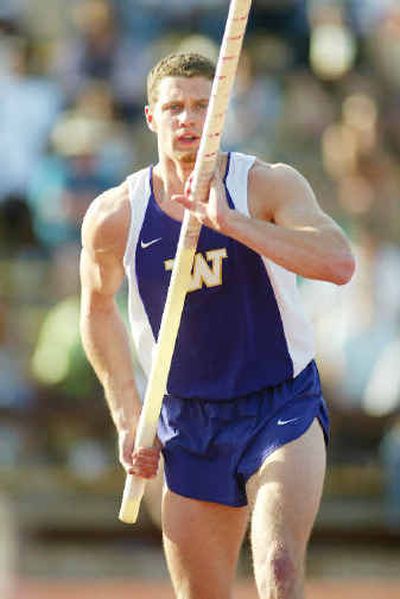Aiming for Athens

Rare enough is the track and field Olympian from Spokane that it’s difficult to resist the temptation to lump them into the same club. An exclusive one, to be sure, and no less so if pole vaulter Brad Walker happens to join it next Sunday.
There is Gerry Lindgren, of course – the high school running wonder of 1964. Phil Shinnick, the long jumper from Gonzaga Prep, made the team to Tokyo that same year. Annette Hand Peters, distance5 diva out of Central Valley, ran in the 1992 Games in Barcelona. And from the mustiest nook of the archives comes the name of Carl Johnson, the long jump silver medalist in 1920 and a graduate of Lewis and Clark High School.
But, frankly, a more relevant parallel to Walker would be a Spokane Olympian of another stripe:
John Stockton.
First, of course, Walker must make the team to Athens. That will require surviving the preliminaries on Friday at the U.S. Olympic Trials in Sacramento, and placing among the top three in Sunday’s final – two encounters with the capricious loon that is the pole vault.
With a clearance of 19 feet, 1 inch this year, the University High School graduate trails only former UCLA vaulter Toby Stevenson on the U.S. list. But there are 10 vaulters with seasonal bests within 5 inches of each other, so handicapping the event is merely a shortcut to self-abuse.
“There are a dozen different guys who could make the team,” Walker acknowledged. “The vault can be unpredictable anyway, but when you figure in the conditions and the extra pressure of the Trials, there’s just no way.
“I know this: as long as I’m focused and do the things I know I have to do, my ability is equal or better than all the people out there.”
It has not taken long for Walker to become so persuaded. In the space of five years, he has catapulted – as if flying on fiberglass – from a pretty fair high school vaulter to world class, a development arc that calls to mind Stockton in a different game and a different time.
One of the Spokane basketball legend’s trademarks was the fact that the higher the level, the more productive his game became. He was a better college player than he was a high schooler, and a better pro than a collegian.
Well, Walker seems to clean up on better pitching, too.
Indeed, since he took up the sport in junior high, Walker has managed to improve his personal best every year but one – vaulting 14 feet as a high school junior after reaching the same height as a sophomore. Otherwise, it’s been up, up and away.
Of course, he’s still a mere 23 years old, but those continual gains – anywhere from six to 14 inches a year, until now – are the exception in the high-wire world of the vault.
“I like to think it’s simple,” he said. “With maturity, if you have speed and strength, you can make significant increases in your PR by fixing some technical things in the vault. Now, there are a lot of technical things – the run-up, tempo, acceleration and turnover at the end, the plant, the takeoff. And there’s even more going on at the top end. But it’s all about going higher.”
Well, yes and no. It’s about beating people, too.
The flakiness of the average vaulter is routinely exaggerated, but Walker should put the stereotype to shame. He has learned, at a relatively young age, to bring his A game to the pit for major meets. Last year, for instance, he won the NCAA indoor title by more than nine inches.
His two 19-foot jumps this season have come at a prestigious vault invitational in Phoenix and at the Prefontaine Classic in Eugene.
And just before the Pre last month, Walker made his first European field trip to test himself internationally and fill in a gap in the U.S. schedule.
“There weren’t many big meets to jump in here in early June,” he explained. “And this gave me a feel of who I might be jumping against if I make it to the Olympics, knowing what to expect, traveling, dealing with fatigue.”
Walker competed in three meets in seven days in Germany and Spain, finishing second, third and fourth with clearances from 17-81/2 to 18-103/4. The vaulters who finished ahead of him were all ranked in the Top 10 last year.
“I wouldn’t say that I don’t feel pressure at big meets,” he said, “but it’s a matter of taking that energy, with all eyes on you, and putting it in the right direction.
“Obviously, once you have all the physical aspects of it, a lot of it comes down to being mentally ready for a meet and that’s a matter of consistency and approach. You’re not going to place well if you’re sporadic – ready for this meet, not ready for that one.”
And now, Walker feels ready – as ready as he’ll ever be. He has competed through and recovered from major injuries – breaks to his foot, his thumb and wrist over the years. He has climbed aboard bigger poles, taken on bigger names, traveled to bigger meets.
Confident as he is, he’s enough of a kid to marvel at his remarkable rise.
“I couldn’t imagine ever not wanting to jump in the Olympics,” he said. “It’s crept up a lot faster than I imagined.
“I remember watching guys like Jeff Hartwig and other big name vaulters and thinking how good they were – how amazing they were. Now I’m competing against them, vaulting at the same bars and it’s pretty exciting. At the same time, it’s time to go to work.”